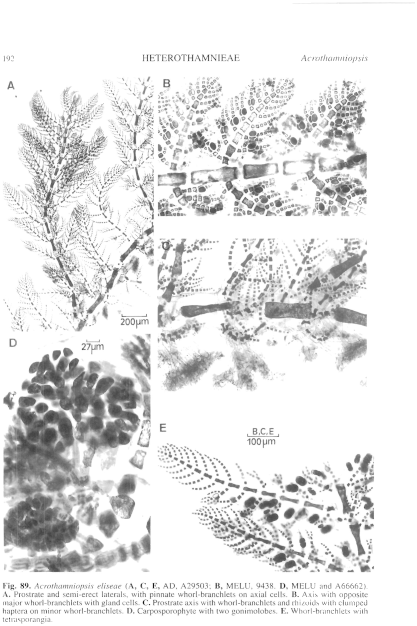|
|
|
|
|
|||||||||||
|
Electronic Flora of South Australia Species Fact Sheet
Phylum Rhodophyta – Order Ceramiales – Family Ceramiaceae – Tribe Heterothamnieae
Thallus (Fig. 89A) medium red, largely prostrate with unattached, more or less erect, lateral branches 2–10 mm long, complanately branched apart from crowding of major whorl-branchlets and the minor whorl-branchlets, each axial cell with 2 opposite major whorl-branchlets (Fig. 89A) and often (not always) with 2 or 4 minor whorl-branchlets, (1–) 2 on each side of the axial cells between the major whorl-branchlets. Attachment by a series of rhizoids with digitate multicellular clumped haptera (Fig. 89C), arising from successive cells of modified rachis cells of minor whorl-branchlets; epiphytic on crustose coralline algae in the upper sublittoral. Structure. Apical cells 6–9 µm in diameter and L/D 1–1.5, increasing evenly over 6–10 cells to axial cells becoming 25–45 (–65) µm in diameter and L/D 3–5, with thick walls. Major whorl-branchlets 200–320 µm and 12–15 rachis cells long, pinnate with opposite pinnules (Fig. 89A, B) themselves becoming pinnate, the lower pinnules 90–120 µm and 8–10 cells long. Minor whorl-branchlets usually evenly spaced between the major branchlets, simple or becoming irregularly pinnate, 90–200 µm long. Lower cells of rachides of major whorl-branchlets 30–40 µm in diameter and L/D 1–1.5 (the basal cell shorter), tapering gradually to terminal cells 6–8 µm in diameter and L/D 1–1.2; pinnule cells isodiametric, 10–12 µm in diameter, tapering to 6–8 µm in diameter, terminal cells with rounded ends; gland cells (Fig. 89B) frequent, cut off from terminal and lower cells, usually situated adaxially on the second to fourth cell of pinnules just below branching, touching the bearing cell and abutting the next upper cell, ovoid, 12–15 µm in diameter. Lateral branches replace (or develop from) major whorl-branchlets, usually alternately and 2 axial cells apart. Cells uninucleate; rhodoplasts discoid in small cells, elongate in larger cells.
Reproduction: Gametophytes dioecious. Carpogonial branches borne on basal cells of 1–3 major whorl-branchlets near axial apices; post-fertilization 1–3 rounded gonimolobes (Fig. 89D) develop, 150–300 µm across, with ovoid carposporangia 20–25 µm in diameter, the carposporophyte remaining terminal on a branch, partly surrounded by whorl-branchlets from below. Spermatangia are terminal on branched filaments arising adaxially on pinnule cells.
Tetrasporangia (Fig. 89E) occur on rachis and lower pinnule cells, sessile or shortly pedicellate, ovoid, 20–30 µm in diameter, tetrahedrally to subdecussately divided.
Type from Point Lonsdale, Vic., on crustose coralline algae, 2.5–4 m deep (Kraft, 1.iii.1992); holotype in MELU.
Selected specimens: Cape Northumberland, S. Aust., on Sporolithon, 2–3 m deep (Edyvane, 5.vi.1982; AD, A55509). Point Lonsdale, Vic., on crustose coralline algae, 2–4 m deep off Lighthouse reef (Kraft, 28.v.1993; AD, A66660-A66662). Point Puer, Port Arthur, Tas., on a crustose coralline alga (Cribb, 31.iii.1950; AD, A29503).
Distribution: Cape Northumberland, S. Aust., to Point Lonsdale, Vic., and SE Tasmania.
Taxonomic notes: A. eliseae appears to be a sublittoral species occurring on crustose Corallinaceae, distinguished by the presence of major and minor whorl-branchlets and the distinctive arrangement of rhizoids.
References:
ATHANASIADIS, A. (1996). Morphology and classification of the Ceramioideae (Rhodophyta) based on phylogenetic principles. Opera Botanica No. 128, pp. 1–216.
The Marine Benthic Flora of Southern Australia Part IIIC complete list of references.
Publication:
Womersley, H.B.S. (24 December, 1998)
The Marine Benthic Flora of Southern Australia
Rhodophyta. Part IIIC. Ceramiales – Ceramiaceae, Dasyaceae
©State Herbarium of South Australia, Government of South Australia
Illustration in Womersley Part IIIA, 1998: FIG. 89.

Figure 89 enlarge
Fig. 89. Acrothamniopsis eliseae (A, C, E, AD, A29503; B, MELU, 9438. D, MELU and A66662). A. Prostrate and semi-erect laterals, with pinnate whorl-branchlets on axial cells. B. Axis with opposite major whorl-branchlets with gland cells. C. Prostrate axis with whorl-branchlets and rhizoids with clumped haptera on minor whorl-branchlets. D. Carposporophyte with two gonimolobes. E. Whorl-branchlets with tetrasporangia.

|
Email Contact: State Herbarium of South Australia |

|